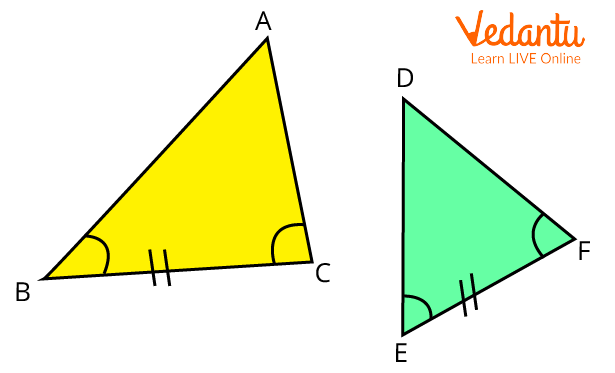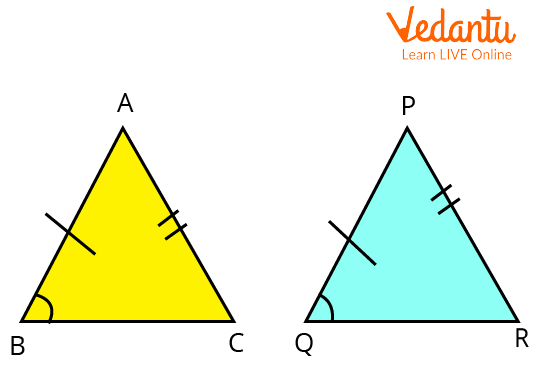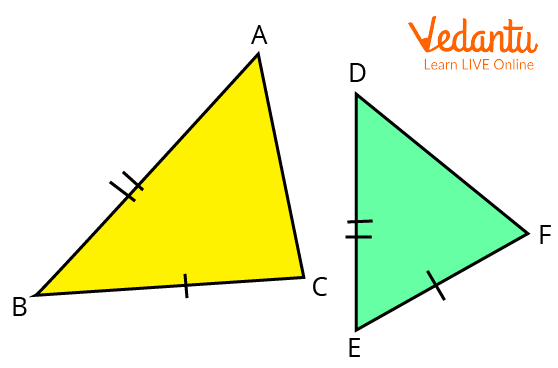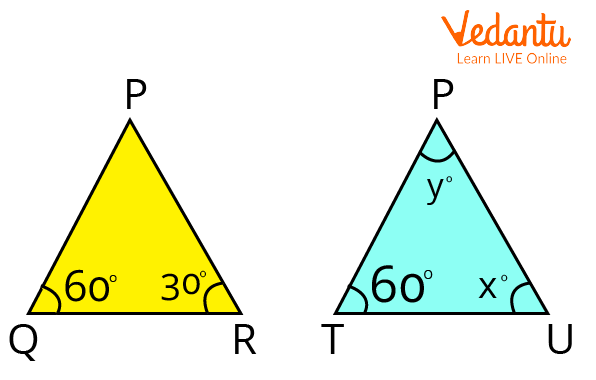




Key Rules of Triangle Congruence Explained for Students
Triangle Congruence Theorem is a fundamental tool of Geometry and two figures in geometry are said to be congruent if they are of exactly the same size and shape. We use Triangle Congruence Theorems to prove if the triangles are congruent or not. In this article, we will discuss the methods to prove triangles congruent in detail.
Statement of Triangle Congruence Theorem
Triangle Congruence Theorem is as follows:
Angle Side Angle Congruence Theorem: Two triangles are congruent if the two corresponding angles equal to each other include a corresponding side that is equal to each other in two triangles.
Side Angle Side Congruence Theorem: Two triangles are congruent if two sides of two triangles are equal including the corresponding angles formed by these sides also equal.
Side Side Side Congruence Theorem: According to SSS congruence theorem, the two triangles are said to be congruent, if three sides of a triangle are equal to the corresponding sides of the other triangle.
Proof of Triangle Congruence Theorem
Angle Side Angle Congruence Theorem
Two triangles are congruent if the two corresponding angles equal to each other include a corresponding side that is equal to each other in two triangles.
Proof:

Triangles ABC and DEF for ASA Theorem
Given:
$B C=E F$
$\angle B=\angle E$
$\angle C=\angle F$
Superimposing both the triangles and aligning them according to the angles and sides.
Align side $E F$ with side $B C$.
Also, $\angle B=\angle E$.
So, the direction of side $E D$ will be the same as the direction of side $B A$.
Also, $\angle C=\angle F$
So, the direction of side $F D$ will be the same as the direction of side $C A$.
So, we can say that the point of intersection of sides $E D$ and $F D$ (that is $D$ ) will coincide exactly with the point of intersection of sides $B A$ and $C A$ (that is $A$ ).
Hence, we can say that both triangles are same in shape and size,
So,
$\triangle A B C \cong \triangle D E F$
Side Angle Side Congruence Theorem
Two triangles are congruent if two sides of two triangles are equal including the corresponding angles formed by these sides also equal.
Proof:
Given: $A B=P Q, B C=Q R, \angle B=\angle Q$.
To prove: $\triangle A B C \cong \triangle P Q R$

Triangles ABC and PQR for SAS Theorem
As done in $A S A$, again superimpose triangles here.
Place the triangle $\triangle A B C$ over the triangle $\triangle P Q R$ in a way that angle $B$ falls on angle $Q$ and side $A B$ falls on the side $P Q$. It is given that $A B=P Q$, so point $A$ falls on point $P$, and $\angle B=\angle Q$, so the side $B C$ will fall on the side $Q R$, and $B C=Q R$, so point $C$ will fall on point $R$.
Therefore, side $B C$ coincides with side $Q R$ and side $A C$ coincides with side $P R$.
So, we have $\triangle A B C \cong \triangle P Q R$.
Hence Proved.
Side Side Side Congruence Theorem
According to the $SSS$ congruence theorem, the two triangles are said to be congruent, if three sides of a triangle are equal to the corresponding sides of the other triangle. Proof:
Given: All sides are equal, i.e., $A B=D E, A C=D F, B C=E F$.
To prove: $\triangle A B C \cong \triangle D E F$.

Triangles ABC and DEF for SSS Theorem
All three sides of both triangles are of the same size and length.
On superimposing both the triangles,
Side $D E$ will be on the side $A B$,
Side $E F$ will be on the side $B C$, and
side $D F$ will be on the side $A C$.
Therefore, $\triangle A B C \cong \triangle D E F$.
Hence proved.
Limitations of Triangle Congruence Theorem
Triangle Congruence theorems are applicable only if triangles are the same in both shape and size.
Applications of Triangle Congruence Theorem
Triangle Congruence Theorem has a wide range of applications in our day-to-day life.
A Truss bridge is made using equilateral triangles applying the triangle congruence theorem.
The theorem is used in understanding the structure of the environment.
Solved Examples
1. Describe the type of congruence in two triangles given by
$\triangle A B C, A B=7 \mathrm{~cm}, B C=5 \mathrm{~cm}, \angle B=50^{\circ}$ and $\triangle D E F, D E=5 \mathrm{~cm}, E F=7 \mathrm{~cm}, \angle E$ $=50^{\circ}$.
Ans:
$A B=E F=7 \mathrm{~cm},$
$B C=D E=5 \mathrm{~cm}$ and
$\angle B=\angle E=50^{\circ}$
So from above, we can say that both triangles are congruent using the SAS congruence criteria.
Therefore, $\triangle A B C \cong \triangle F E D$ (SAS).
2. In a $\triangle A B C$, if $A B=A C$ and $\angle B=70^{\circ}$, find $\angle A$.
Ans:
In a $\triangle A B C, A B=A C$ and $\angle B=70^{\circ}$
$\angle B=\angle C$ (as angles opposite to equal sides of a triangle are also equal)
Therefore, $\angle B=\angle C=70^{\circ}$
Sum of angles in a triangle $=180^{\circ}$
$\angle A+\angle B+\angle C=180^{\circ} $
$\angle A+70^{\circ}+70^{\circ}=180^{\circ} $
$\angle A=180^{\circ}-140^{\circ} $
$\angle A=40^{\circ}$
3. In the given congruent triangles under $A S A$, find the value of $x$ and $y$ where $QR=TU$.
Ans:

Triangles PQR and PTU given in the question
Given: $\triangle P Q R=\triangle P T U$ (By ASA rule)
$\angle Q=\angle T=60^{\circ}$ (given)
$QR=TU$
$\angle x=30^{\circ}$ (for ASA rule)
Now in $\triangle \mathrm{PTU}$,
$\angle P+\angle T+\angle U=180^{\circ}$ (Angle sum property)
$\angle y+60^{\circ}+\angle x=180^{\circ}$
$\angle y+60^{\circ}+30^{\circ}=180^{\circ}$
$\angle y+90^{\circ}=180^{\circ}$
$\angle y=180^{\circ}-90^{\circ}=90^{\circ}$
Hence, $x=30^{\circ}$ and $y=90^{\circ}$.
Conclusion
In the article, we have discussed the detailed proof of Triangle Congruence Theorems. All the different ways to prove that the triangles are congruent are discussed above. Real-life examples of the theorem are also discussed. The Triangle Congruence theorem forms an important tool of geometry and is an essential element of geometry to study objects of the same size and shape.
FAQs on Triangle Congruence Theorem: Definition, Proofs & Examples
1. What are the five main criteria or theorems for proving that two triangles are congruent?
To prove that two triangles are congruent, you must satisfy one of the five established criteria. These are the minimum conditions needed to guarantee the triangles are identical in shape and size:
- SSS (Side-Side-Side): If all three sides of one triangle are equal in length to the corresponding three sides of another triangle.
- SAS (Side-Angle-Side): If two sides and the included angle (the angle between those two sides) of one triangle are equal to the corresponding two sides and included angle of another triangle.
- ASA (Angle-Side-Angle): If two angles and the included side (the side between those two angles) of one triangle are equal to the corresponding two angles and included side of another triangle.
- AAS (Angle-Angle-Side): If two angles and a non-included side of one triangle are equal to the corresponding two angles and non-included side of another triangle.
- RHS (Right Angle-Hypotenuse-Side): This special case applies only to right-angled triangles. It requires that the hypotenuse and one corresponding side are equal.
2. What is the key difference between congruent triangles and similar triangles?
The key difference lies in size. Congruent triangles are identical in both shape and size; all corresponding sides and angles are equal. Think of them as perfect clones. Similar triangles, however, have the same shape but can have different sizes. Their corresponding angles are equal, but their corresponding sides are in proportion. In essence, all congruent triangles are similar, but not all similar triangles are congruent.
3. What does CPCTC mean and why is it so important in geometry?
CPCTC stands for “Corresponding Parts of Congruent Triangles are Congruent.” Its importance lies in what you can do *after* you've proven two triangles are congruent. Once you establish congruence using a criterion like SAS or SSS, you can use CPCTC as a reason to state that all other corresponding parts (sides and angles) are also equal, without needing to measure them directly. It's a powerful tool for solving for unknown angles or side lengths in geometric proofs.
4. Why isn't there an Angle-Angle-Angle (AAA) congruence theorem?
There is no AAA congruence theorem because knowing that all three corresponding angles are equal only proves that the triangles are similar, not congruent. For example, an equilateral triangle with 2 cm sides and another with 10 cm sides both have angles of 60-60-60. They have the same shape but are clearly not the same size. To prove congruence, you need information about at least one side to fix the triangle's scale.
5. What are some real-world examples where triangle congruence is important?
The principle of triangle congruence is fundamental in many fields for ensuring stability, consistency, and reliability. Key examples include:
- Construction and Architecture: Triangular trusses used in bridges, roofs, and towers rely on congruent triangles to distribute weight evenly and prevent structural collapse.
- Manufacturing: In mass production, identical parts (like machine gears or electronic components) are manufactured as congruent shapes to ensure they are perfectly interchangeable.
- Navigation and GPS: Triangulation techniques use principles related to triangles to pinpoint exact locations.
- Art and Design: Artists use congruent shapes to create patterns and tessellations that are symmetrical and visually balanced.
6. How does the RHS (Right Angle-Hypotenuse-Side) criterion differ from SAS (Side-Angle-Side)?
The primary difference is the position of the angle relative to the sides. In SAS, the angle must be the included angle, meaning it is located directly between the two known sides. In RHS, which only applies to right-angled triangles, the known angle is the right angle, but it is *not* between the known sides (the hypotenuse and a leg). RHS is a unique case because the length of the hypotenuse in a right triangle constrains the triangle's shape in a way that doesn't happen with a non-included angle in other triangles.
7. If we prove two triangles are congruent, does that mean their areas and perimeters are also equal?
Yes, absolutely. Since congruence means all corresponding sides are equal in length, the perimeter (the sum of all three sides) of both triangles will be identical. Similarly, because all sides and angles are equal, their heights and bases will also be equal, which means their areas (calculated as ½ × base × height) must also be exactly the same. This is a direct consequence of the definition of congruence.























